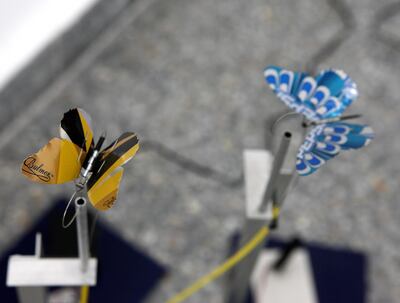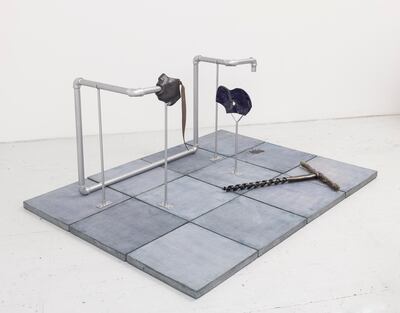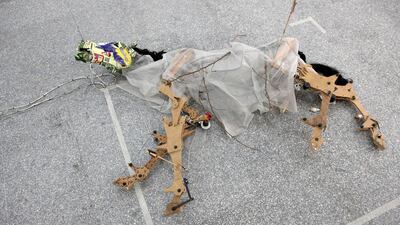Growing up in the United States, Syrian-American curator Ruba Katrib felt removed from her Arabic roots. But after 9/11, and launching into a career in the art world, she embarked on a mission to create meaningful bridges in an increasingly polarised world. Her first exhibitions at MoMa PS1 celebrate marginalised experiences.
Katrib’s parents both left Salamiyah, Syria, to study and pursue their American dream. Katrib was born in Maryland and grew up in West Virginia among a group of immigrant children.
Her family celebrated Eid, visited the local mosque, cooked traditional dishes, and visited Syria once a year, but increasingly the young generation’s Arabic was lost as they struggled to learn English and integrate.
"Arabic was my first language, but the teachers were afraid that I wouldn't learn English," says Katrib, 36, who lives in Brooklyn. "My father, a doctor, wore a kandura and cooked foul (fava beans), so I felt different. Then, with time, my parents assimilated more and more."

Increasingly sensitive to the tensions and alienation of the Arab-American experience, Katrib’s sense of identity shifted; she developed a critical distance from both cultures. While she studied at the School of the Art Institute of Chicago (she later graduated with a masters from the centre for curatorial studies from Bard College), 9/11 struck and changed the reality of Muslims and Arabs around the world.
"When things escalated politically and the anti-Muslim, anti-Arab sentiment grew, our identities became politicised and we developed a sense of fear," she says. "I'm interested in tackling these questions, and the history and impact of colonialism and its contemporary manifestations."
Today, Katrib is part of a young generation of prominent curators bringing different perspectives to the art world.
After six years working at the SculptureCentre in Queens, where she is adjunct curator and is organising an exhibition with artist Lawrence Abu Hamdan, she was appointed as a curator at MoMa PS1 in Long Island City, Queens, the museum's more experimental space. She also writes and is a research adviser for the 2018 Carnegie International and curator for Santa Fe's 2018 biennial, among other projects.
Her two debut exhibitions at PS1 showcase her interest in art that is meaningful and political, aesthetically moving and intellectually provocative. The indigenous Mexican artist Fernando Palma Rodriguez, whom she first met in Oaxaca, crafts semi-robotic sculptures out of found material such as paper, dirt, stone, feathers, sewing machines and memorabilia. These creatures are reminiscent of the animal gods of Aztec myths, symbolising native cultures crushed by colonisation, the industrial revolution and multinationals.
“Fernando is dealing with the indigenous struggle in Mexico, environmental crises and the basic battle for human rights,” Katrib says. “It’s a conversation that isn’t simply didactic, and I’m sharing this work with audiences in New York where there’s a huge indigenous population.
“I want to make these connections through my work as a curator. There’s an issue of otherness that comes to play in this humanitarian and land crisis. Multinationals have extracted more gold than the Spanish in the past 300 years, so it’s colonialism on speed. This hypocrisy is inescapable and it’s important to share information and evoke action,” she says.
Although the hyper-commercialised, elitist art world isn’t always open to criticism and political controversy, Katrib feels that the current cultural climate has triggered more interest in activism and alternative points of view.
“I think we live in an amazing time because people are ready to hear these critiques,” she says. “There’s an openness about this. For example, in the case of Fernando’s work, people have compassion about the indigenous struggle and I think his work is more effective now.
“My work is to react to the urgency in culture, identify the artists dealing with important issues that will be well received. Timing is really important. It’s hard to ask art to do anything specific – it’s about introducing different ideas, different ways of thinking, and creating empathy. It can move people.”
The other artist Katrib has selected for her curatorial debut at PS1, Julia Phillips, also tackles themes of violence and oppression, but in a more covert, ambiguous manner.

Her delicate ceramic sculptures evoke medical instruments, body parts and torture chambers. Several sculptures in the show were commissioned by Katrib, who first met the artist at Columbia University’s MFA graduate show.
“Her work evokes the body in space,” Katrib says. “Most of her sculptures resemble devices and medical tools used in relation to the body, and they relate to aspects of control, pain, pleasure – physically and psychologically.
“It’s about this way of considering the political body as instrumentalised by society and culture. She is evoking a universal body.”
Julia Phillips's exhibition, Failure Detection, and Fernando Palma Rodriguez's exhibition In Ixtli in Yollotl, We the People, are on until September 3 and September 10 respectively at MoMa PS1, Queens, New York
_______________________
Read more:
A new project traces the history of the UAE's urban design
10@10 podcast: The UAE arts scene with Sultan Sooud Al Qassemi
10 artists to look out for at this weekend's World Art Dubai
_______________________

